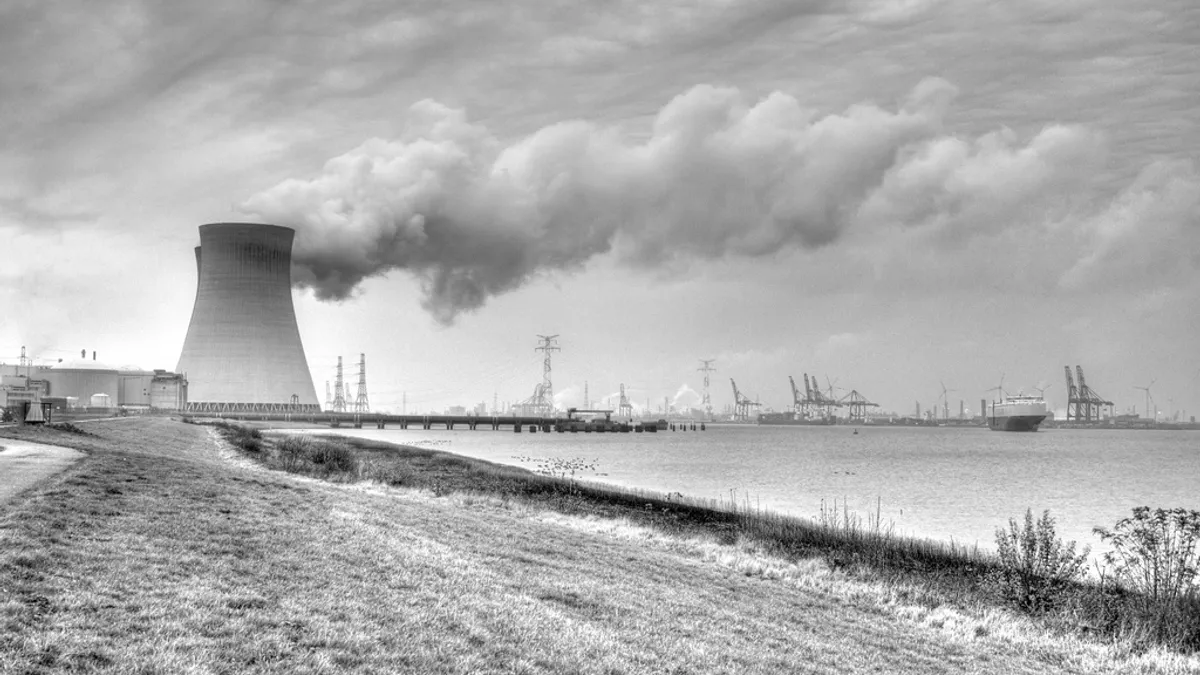Dive Brief:
- Up to 11% of the United States' nuclear generation fleet is at risk of early retirement, according to analysis of industry assessments from three major rating agencies completed by SNL.
- UBS, Moody's and Fitch collectively identified a dozen units they considered "at risk" of early retirement largely due to their inability to compete in power markets. The most recent sign nukes are having trouble competing is Entergy's announcement last week that it plans to close the 680 MW Pilgrim Nuclear Power Station in Plymouth, Mass., by 2019.
- While some states are considering new nuke plants for Clean Power Plan compliance, industry analysts warn that widespread nuclear retirments could make the emissions goals under the plan impossible.
Dive Insight:
Rock bottom natural gas prices have put the squeeze on nuclear generation, and an analysis by SNL shows that a significant chunk of the carbon-free generation may be at risk. The 12 units identified by ratings agencies as struggling in power markets represent more than 10,000 MW of capacity.
There are varying reasons plants may shutter early, before their licenses expire, but the predominate issue of late has been low gas prices. Entergy made its announcement last week — the plant was among the dozen "at risk" — and said both current and forecast power prices have fallen about $10/MWh, which the company estimated as an annual loss of more than $40 million in revenues for Pilgrim.
Bill Mohl, president of Entergy Wholesale Commodities, called the decision "agonizing."
"When we look at energy policies in Massachusetts, we see a proposed clean energy standard that excludes nuclear, a preference for Canadian hydro power and the subsidization of gas pipeline capacity through electric ratepayers, and put that all together ... and it became clear to us that we needed to make the decision to retire Pilgrim," Mohl told the Associated Press.
There are a few brighter spots for the nuclear industry, however. Last week, the Nuclear Regulatory Commissioned indicated it is close to issuing the first license for a new nuclear plant in nearly 20 years for the second unit at TVA's Watts Bar plant, and construction continues at the Vogtle nuclear facility in Georgia and V.C. Summer nuclear facility in South Carolina, though both projects have been plagued by cost overruns.
North Carolina has also indicated it will consider more nuclear power for Clean Power Plan compliance if its legal challenge to the rule fails. Department of Environmental Quality Secretary Donald van der Vaart has said officials are also looking at nuclear generation as a way to "leapfrog" natural gas.
"The real discussion we need to be having in North Carolina is about nuclear power, and it is a discussion we are having," van der Vaart said recently at the John Locke Foundation. "[Nuclear] is really the dual plan to put in place in case we lose the litigation, because we need to leapfrog natural gas."
Beyond that, the finalization of the Clean Power Plan was a mixed bag for the industry. Under the plan, states will receive credit toward emissions goals for nuclear plants currently in construction, but the EPA stopped short of including calculations for nuclear plants in their baseline emissions rates for each state. While existing nuclear generation does keep CO2 emissions lower than they would otherwise be, the agency decided it would be “inappropriate” to use existing nuclear generation to lower the carbon targets states must meet by 2030.
The nuclear industry welcomed the inclusion of its zero-carbon generation in the baseline rates, but said the agency should have done more to protect existing plants from retirement. A much-publicized report from the centrist think tank Third Way last month predicted that widespread retirement of nuclear plants could make the Obama administration's plan impossible to attain, though critics said the study failed to consider how renewables and efficiency, rather than natural gas, could pick up the slack for old nuclear plants.














